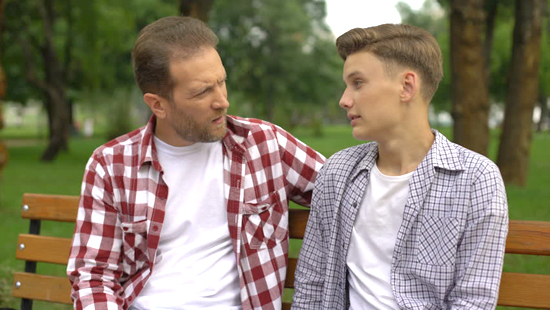Relationship with Children
How to Acknowledge Negative Feelings

Use Acknowledge Negative Feelings to meet your child’s need to feel heard and understood.
If you are not used to acknowledging negative feelings, it might feel awkward at first, but don’t give up. When you see the results, you will be glad you persisted.
The hardest part about acknowledging negative feelings is taking the time to do it. When your child comes to you in distress, it’s rarely at a convenient time. So you have to decide, do I take the time now, or do I postpone. If you postpone, arrange a time to talk later.
There are two steps:
- Listen
- Show that you understand
Step 1. Listen
Step 1 is how you meet your child’s need to be heard. You listen.
Listening means 1) stop what you’re doing, 2) make eye contact, and 3) give your full attention.
This will make your child feel important and meet his need for a sense of belonging. Try not to multi-task while listening. If your phone rings, silence it or tell the caller you’ll call them back.
Just listen.
Step 2. Show that You Understand
Sometimes you don’t even have to go on to step 2. Listening will often enable your child to let go of his negative feelings and fix the problem on his own. You’ll know that your conversation is done when he says, “Thanks dad, see ya.”
Step 2 is to meet your child’s need to feel understood.
This is where you give a summary of how the child is feeling and why he is feeling that way. Some people call it reflecting because you reflect back to the child what you are understanding. Showing that you understand has two parts that you can use in any order:
- Identify how the child is feeling
- Summarize why the child is feeling that way
Identify How the Child is Feeling
Use words that describe how the child is feeling. I call these “feeling words”:
Mad – “You are mad.”
Frustrating – “That can be so frustrating.”
Sucks – “Oh, man, that sucks.”
Tough – “Oh, man, that is tough.”
Disappointing – “How disappointing.”
Embarrassing – “That must have been embarrassing.
“Ohh noo” – This is a generic response to any distressful situation the child throws at you.
Reflect Why the Child is Feeling that Way
The child is telling you the story surrounding his distress. Simply reflect that back.
Child: I’d like to punch that Michael in the nose. We were playing soccer and he pushed me down.
You“You were both going after the ball and he pushed you down.
Child: “My teacher is stupid. Just because of a little rain she said we couldn’t go on our field trip.”
You: “Your teacher cancelled your field trip after you’ve been looking forward to going.”
Reflect and Identify the Feeling
Here are some examples of ways to say how the child is feeling AND why the child is feeling that way.
Child: I’d like to punch that Michael in the nose. We were playing soccer and he pushed me down.
You: “You were both going after the ball and he pushed you down. That made you mad”.
Child: My teacher is stupid. Just because of a little rain she said we couldn’t go on our field trip.
You: “Your teacher cancelled your field trip after you’ve been looking forward to going – how disappointing.”
Child: “Basketball sucks. Tom and Bill made the team but I didn’t.”
You: “You were cut from the team? Ohh noo.”
The Spinning Chair
One day my grandchildren were visiting. 4-year old Brooklyn and her 3-year old brother, Stockton, came into the family room and spotted the spinning chair. The spinning chair is an office chair that the grandchildren love to sit on and spin around.
Both made a dash for the chair. Stockton got there first and climbed up onto it. I could see Brooklyn fuming and I was afraid she was going to do something mean to Stockton.
The first thing that came to my mind was to say, “Brooklyn. Let Stockton have a turn and then it will be your turn.” That makes perfect sense, right? It’s so logical. Then I remembered Brooklyn’s need to feel heard and understood in a distressful situation. And she was in distress.
I went over to Brooklyn, kneeled down so I was eye-to-eye with her and said, “Brooklyn. You are really mad. You wanted to beat Stockton to the chair and I think you even wanted him to push you around.”
She didn’t say a word, but I could see her whole body relax. She turned around and off she went.
You’ll notice I didn’t give advice, tell her to get over it, or tell her to stop being a baby. All I did was summarize how she was feeling and why she was feeling that way.